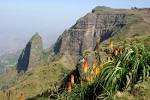Location of Simien Mountains Ethiopia.
The Simien Mountain National park is located, in the Amhara regional Government state, North Gondar Zonal, 886-km distance from the capital, Addis Ababa and 123 km from Gondar 13°Nl,38°E lies between the altitudinal range of 1900 masl to 4430 masl at Bwahit in northern west of Ethiopia. More importantly, it is also located on the northern edge of the Great Rift Valley, which passes through Ethiopia and down to Mozambique, stretching over 6000 km. The mountain nature of the park together with its surrounding high peaks gives rise to the name The Roof of Africa. The SMNP is endowed with unique landscape and endemic animals, plants found only in the Ethiopian Highlands.

Simien Mountains – Geology of simian mountains National park Ethiopia. Geological history of the Simien Mountains was as mentioned below. The Simien Mountain were formed lava outpouring In the Miocene and Oligocene geological periods. These trap lavas covered all the pervious rock formation and the type of volcanic activates were like the ͑͑Hawaiian҆҆ type /found in china/ and spread over a wide area everything about 15,000 km² or more. These trap lavas hardened slowly forming a profile with gently sloping side like the Hawaiian volcanoes.

Climate of Simien Mountains National park Ethiopia.
The Climatic of SMNP is dependent on great altitudinal variation and mountains landscape categorized by6 wet, cool, and cold seasons. These climatic conditions are traditionally classified in four major climate zones as Woina Dega (1900-2400masl sub tropical climate) Dega (2400-3400masl temperate climate) High Dega (3400-3700masl cool climate) Wurch zone (>3700masl alpine).

Simien Mountains Natinal park- Wildlife in the Simien Mountains.
There are 22 large mammals, 13 small mammals and 182 bird species currently living in the mountains, of which 3 large mammals, 8 small mammals and 6 bird species are endemic to Ethiopia.
Gelada baboon in Simien National park.
The Gelada is an old-world monkey; not a baboon despite previous naming conventions. It is the only living member of the once widespread genus The ropithecus, and is only found in the highland of Ethiopia. The present-day distribution of the gelada is limited to the steep escarpments and gorges that border the eastern side of the central highlands and the north western highlands of Ethiopia

Walia ibex in Simien Mountains.
The Walia Ibex is found solely in the Simien Mountains, usually between 2,500 and 3,000m. They tend to live in groups and they forage in open spaces. The first record of the Walia was in 1835 by the explorer Rupell. Local legend states that the Walia came to the park with the saint Kidus Yared who used them to carry his holy books.
Ethiopian wolf in Simien Mountains National park.
The Ethiopian wolf is one of the rarest animals in the world. It is also Africa`s most threatened carnivore. The closet living relatives of the Ethiopian wolf are grey wolves and coyotes. The Ethiopian wolf ancestor crossed over from Eurasia during the Pleistocene period about 100,000 years ago, when sea levels were lower and Africa / the Middle East were connected.

Birdlife in Simien Mountains.
Well known bird species include: Watt led libs (bostrychia carunculata) The thick -billed raven (corves crassirostris) The tawny eagle (Aquila rapax). Bearded vultures (Gypaetus barbatus).
Plants in Simien Mountains.
Plant composition diversity refers tovegetation richness of the SMNP. Morethan 1,200 plant species with diversifiedfloristic composition in wide range ofaltitudes are believed exist in SMNP.About 507 species are identified and described of which about 57 tree speciesare identified in and around SMNP andover 20 plant species estimated areendangered. Out of 52 species of grasses10 are endemic to Ethiopia and only 3 areendemic to the Simien.

Rainfall in Simien Mountains.
The type of rainfall in the park area is characterized as 1 long eight month rainy season and a ideal hiking condition four-month dry season. The big rains begin in June and last through to September, after decreases with sporadic rainfall and fog. In the SMNP there is a relationship between rainfall and altitude. Rain increases with altitude up to 3,500-m altitude and begins to fall again. This is because the condensation usually fails to ascend up to the highest peak.
Temperature In Simien Mountains
The maximum temperature in the mountains is 15°C during the day and usually drops between -3 and 5°C at night with the coldest months being October, November, December, and January. In the
dry season temperatures can drop as low as -30°C at night at the higher altitudes with occasional snowfalls. Between June and late September is considered rainy season in Ethiopia.

What to bring whilst traveling in Simien Mountains.
From the beginning of December to the end of January, the temperature drops from -1 up to -3 during the night while during the day temperatures can reach as high as 25+; as a result, we recommend you bring: Sunscreen, Sleeping bag (three season at the very least), Gloves, A long
jacket, Other warm clothing, Thermal layers, Head beanie The temperature during the rainy season of June and July is the other way round. It gets cold during the day because of the rain and fog, whereas during the night it gets warmer as clouds keep the temperature higher. Light and waterproof materials are recommended at this time of the year since rain is highly expected and besides this it is very important to have with you those individual kits which listed below: Torch with spare batteries, Small travel alarm/reliable watch, Earplugs, Dark sunglasses, Spare spectacles (or lens prescription), Detergent, Polythene bags Sewing kit/String (clothes line/repairs etc.), water purification tablets, and any Personal medication desired. Some hikers with minimal experience occasionally pack altitude sickness pills if they plan on summiting Ras Da

Written by Simien Mountain Expert Guide Berhanu Asrat

WhatsApp:+44 77 35056586
Info@myescapetonature.com

